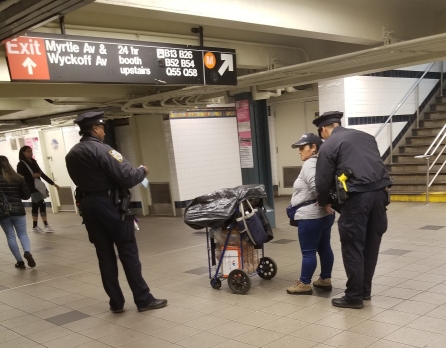
More mental-health help and supportive housing for the homeless. Fairer transit fares for low-income New Yorkers. Greater frequency of train and bus service to lessen off-hour waits. Courteous cops focused on surveying platforms for major crimes — not hassling churro sellers or teenaged fare beaters. Accessible stations that enable more people to use the trains. Climate-resilient subways that don’t flood.
These are some of the common-sense policy recommendations in a new report from transit-advocacy group Riders Alliance, “A Riders Plan for Public Safety,” which seeks a comprehensive approach to the ills dampening public enthusiasm for mass transit, which has rebounded to only 60 percent of its pre-pandemic capacity.
The 12-page plan, to be released at a rally in Brooklyn’s Barclays Center at noon today, distills insights from a range of fields — and from the common wisdom of Riders advocates — to arrive at its solutions. Largely, however, it functions as a plea for politicians to stop using the subway as the all-purpose whipping post for public anxieties — and to stop throwing more cops, and only cops, at the subway’s multifaceted problems.
“Beyond simply trying to stop violence, politicians and media outlets exploit instances of crime underground to distract from scandal and difficult-to-tackle policy matters and to justify harsher law enforcement from bail reform rollback to fare evasion arrests,” the report says. “In this environment, it’s little wonder that, even with more police officers in the subway, the appetite for yet more patrols keeps growing. But over several decades leading up to 2020, subway crime dropped sharply as ridership grew, even while the number of officers in the system declined.”
Moreover, with fear of crime rising because of the great social disruptions of the pandemic, the authors think that their plan “has broader implications” for America. “More than ever, grandstanding and fear mongering threaten not only individual lives, families and communities, but the future of our political system,” the report says, proposing “transportation, housing, healthcare and policing solutions to make a subway where everyone feels safe, welcome, and included — against a backdrop of a nation torn apart, too often in the name of law and order beneath New York City streets.”
The report proposes that the MTA:
- Run trains every six minutes throughout the week: “More frequent service would make public transit much safer by (a) shortening lonely waits on platforms and at bus stops… (b) reducing frustration that contributes to disputes between riders and assaults on transit workers, and (c) speeding door-to-door trips, attracting more riders and creating safety in numbers.”
- Improve station staffing: “Ambassadors and wayfinders in station booths and on platforms and mezzanines can provide a range of important services for riders, from facilitating fare payment to giving directions to deterring harassment.”
- Better station design and evacuation procedures for all riders, especially those with disabilities.
It calls on the state to:
- Protect tenants by passing “good cause” eviction legislation. A state legislature bill on the matter died in committee this year.
- Make it easier to convert hotel and office properties into affordable housing, especially in midtown Manhattan. Gov. Hochul recently took steps in this direction, signing a bill that would relax the rules for converting underutilized hotels into permanent housing.
The city, for its part must:
- Stop the homeless “sweeps” and open at least 3,000 beds in private, single-occupancy rooms for the unsheltered.
- Add at least 12,000 more apartments a year for homeless and very low-income families.
- Establish community-based units for mental-health emergencies near public transit. “Half of hate crimes are committed by people with mental illness, and that’s just the folks who have diagnoses already,” the report notes. “Racial and gender harassment are worse because of gaps in mental healthcare for those who need it.”
The NYPD, meanwhile, should not:
- Arrest, harass, or confiscate the wares of subway food vendors: “NewYorkers’ subway commutes are some of the longest in the nation and riders appreciate being able to buy snacks from vendors who also serve as eyes and ears on our transit system.”
- Arrest fare-evaders: “Use of force and collateral consequences are grossly disproportionate to nonpayment of a $2.75 transit fare.”
- Evict unhoused New Yorkers from the subway or issue them tickets: “Already this year, massive subway and encampment sweeps have cost millions of dollars and upended thousands of lives without solving any housing problems.”
Or, as one Riders advocate put it, cops in the subway “don’t do much to deter actual crime, instead focusing on … non-violent offenses.” The advocate recounted that, two years ago, he “was harassed and threatened with homophobic violence on a subway platform. There were police in the station, but they were too busy looking out for turnstile jumpers to patrol the platform and intervene in my situation. When I approached them for help, they didn’t seem interested or concerned. Why are police focusing on fining people who didn’t have $2.75 to pay for a subway ride, instead of ensuring a safe commute for riders?”
The recent arrest of a fruit vendor in a Brooklyn subway station has sparked outrage from her New York City community. Maria Falcon was taken into custody on April 29 for selling mangoes and kiwis inside the Broadway Junction station. pic.twitter.com/gAMBqfJpmI
— PIX11 News (@PIX11News) May 10, 2022
As the plan concludes: “Focusing on crime and punishment in transit, too often to the exclusion of all other problems and solutions, distracts and deflects from the need to improve transit service and provide for the most vulnerable New Yorkers. Seeing the subway as a political symbol rather than a transportation network contributes to threats against its viability by obscuring riders’ needs.”
Read the full Riders Alliance plan here:







